In order to make sense of the Abrahamic Family House, a lavish religious complex designed by David Adjaye on Abu Dhabi’s Saadiyat Island, one might begin a few hundred yards away, in a darkened gallery at the Jean Nouvel–designed Louvre Abu Dhabi. There, bathed in warm light, sit a Yemeni Hebrew Torah, a two-volume Parisian Gothic Bible, and a decorated Quran from Damascus—the three “Religions of the Book,” as the wall text refers to Judaism, Christianity, and Islam, brought together in a display of religious harmony. At the Abrahamic House, the tableau has undergone a leap in scale and medium, emerging in the tripartite form of a mosque, a church, and a synagogue, each a 100-foot-tall cube of bush-hammered concrete, that stand atop an expansive limestone plaza. The message, too, has grown in its pretensions: whatever their differences, this complex suggests, these peoples of the book are united by a common origin—and under the model of tolerance promoted by the United Arab Emirates, peaceful coexistence lies squarely within reach.
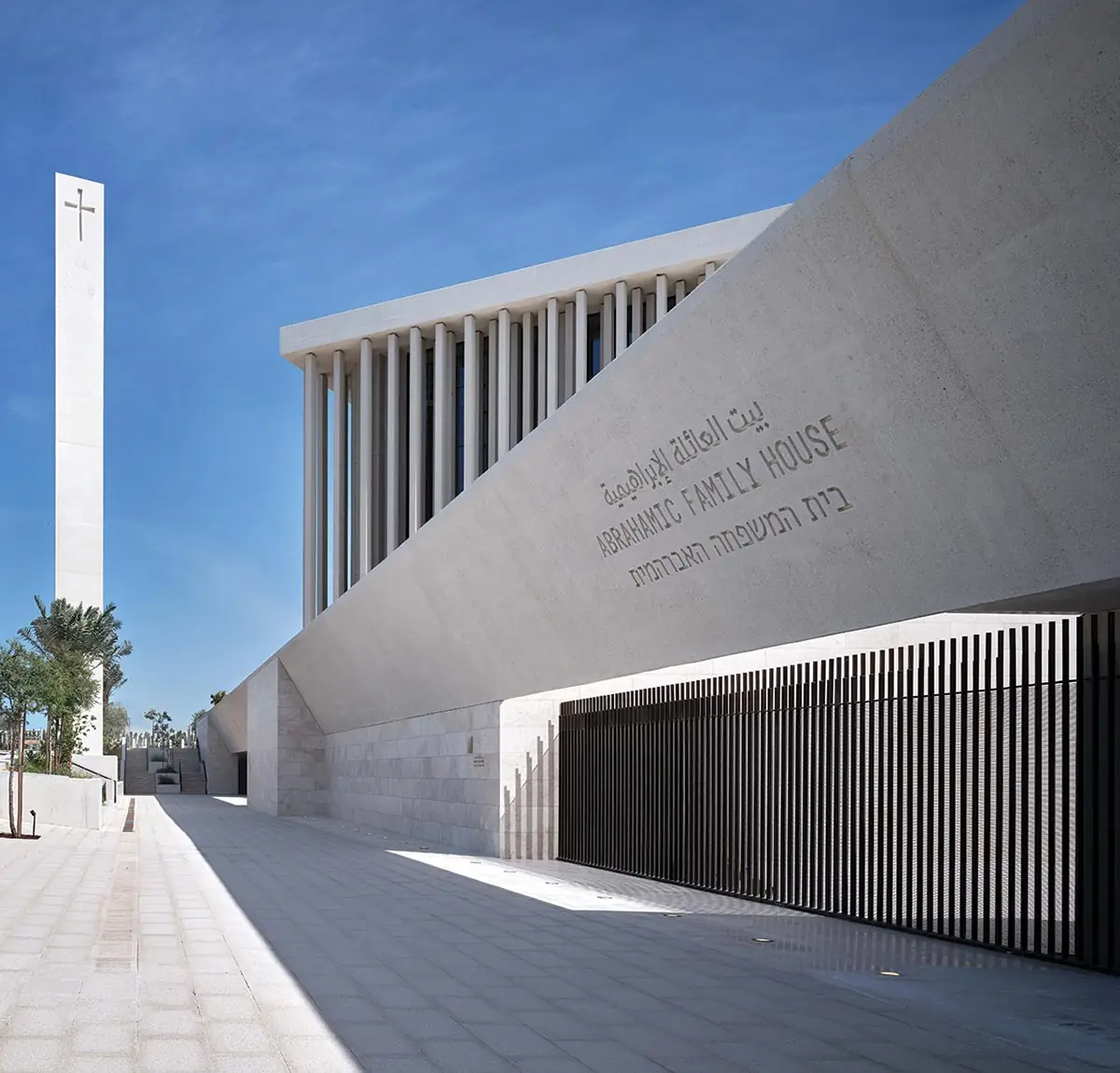
Visitors can enter through a welcome center, or climb up to a landscaped plaza. Photo © Dror Baldinger, click to enlarge.
Absent from Adjaye’s composition, as from the Louvre gallery, is any acknowledgement of the brutal conflict that has marked the intertwined histories of the three faiths—and that continues today in the form of ongoing violence and dispossession of land. But to grapple with history was never the point. Nor was it to create needed spaces of worship: no Jewish or Christian congregation sought a home here, and mosque construction in the Emirates is tightly controlled by the government. Rather, the Abrahamic House is primarily a geopolitical event, to borrow the scholar Nasser Rabbat’s apt description of the building of the nearby Louvre. Both grands projets are master classes in the projection of soft power on the part of Abu Dhabi ruler and UAE president Sheikh Mohamed bin Zayed Al Nahyan. Both position the Emirates as a champion of enlightened values, primarily for the benefit of foreign audiences, and both leverage the prestige of their architects to do so. Both are also tied to immediate diplomatic priorities: the Louvre was developed in parallel with a nearby French naval base, and the Abrahamic House was conceived to commemorate Pope Francis’s 2019 visit to Abu Dhabi as well as the UAE’s inauguration of diplomatic relations with Israel under the 2020 Abraham Accords. Ebtesam Al Ketbi, the president of the government-aligned Emirates Policy Center, has described the Abrahamic House as a site of “religious diplomacy,” and its construction accompanies a deepening in ties that was punctuated, last September, by Israel’s decision to sell a missile defense system to the UAE for the first time.
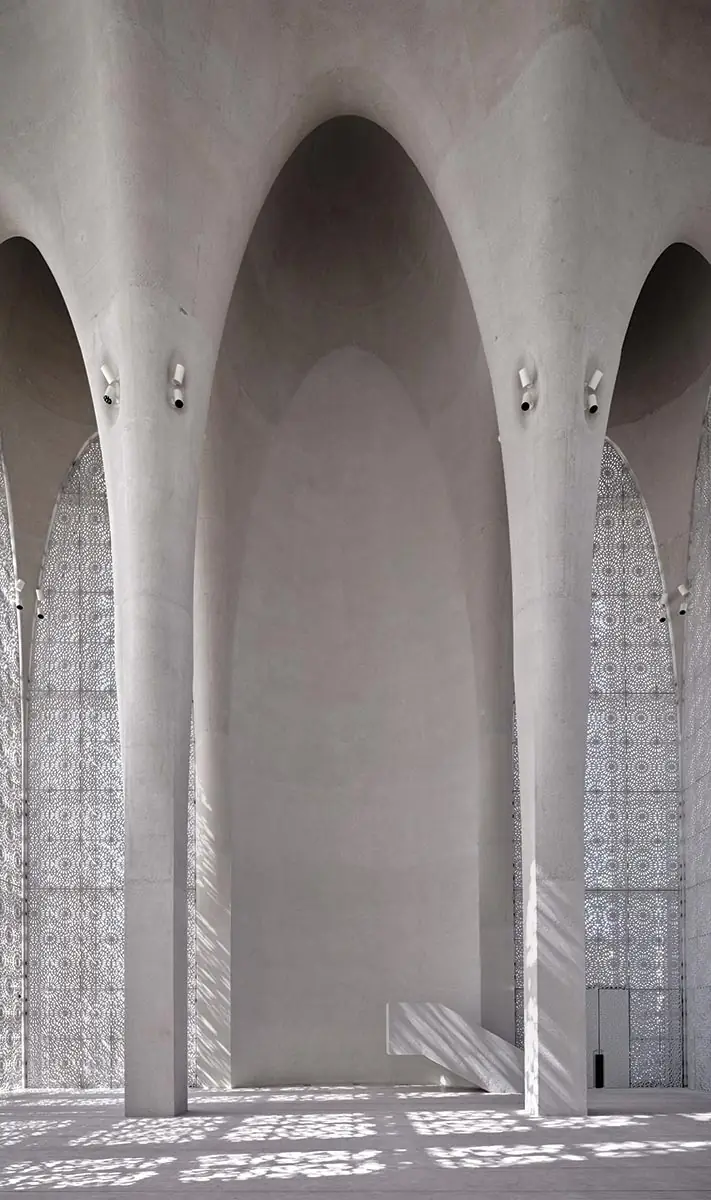
Daylight filters into the mosque via mashrabiyalike screens. Photo © Dror Baldinger
In such a context, the task given to the architect is only nominally religious: the real aim is to monumentalize the ambitions of the state. This, Adjaye has done with aplomb. In contrast to the playful libraries and community centers he has designed around the world, and to his dark, diaphanous National Museum of African American History and Culture in Washington, D.C., which stands in resolute contrast to its white-stone neighbors, the Abrahamic House projects authority unquestioningly. Its heavy, tripartite composition, pinwheel-like in plan, conjures a weighty sense of history without creating a hierarchy among the mosque, church, and synagogue—as project architect Stuart Rennie puts it, the challenge was “how you make these three structures harmonious rather than conflicting.” Adjaye’s solution was to differentiate the trio through facade articulation and interior spatiality. The mosque’s facades are marked by a set of stretched parabolic arches that grow taller near the center, suggesting the outline of a larger arch; the interior, which consists of nine soaring domes, is illuminated by daylight filtered through tall mashrabiya screens. The church’s facades, by contrast, are made up of dozens of columns arrayed in several layers to create a forest-like effect, foreshadowing an interior dominated by an enormous sculptural composition of vertical oak boards that take the form of two intersecting naves. And the synagogue’s exterior is defined by muscular Y-shaped columns that create a repeating pattern of large triangular openings; these allow daylight inside, where a vast, shroud-like scrim hangs from the ceiling and helps prevent glare. To say the least, all three are memorably grand.
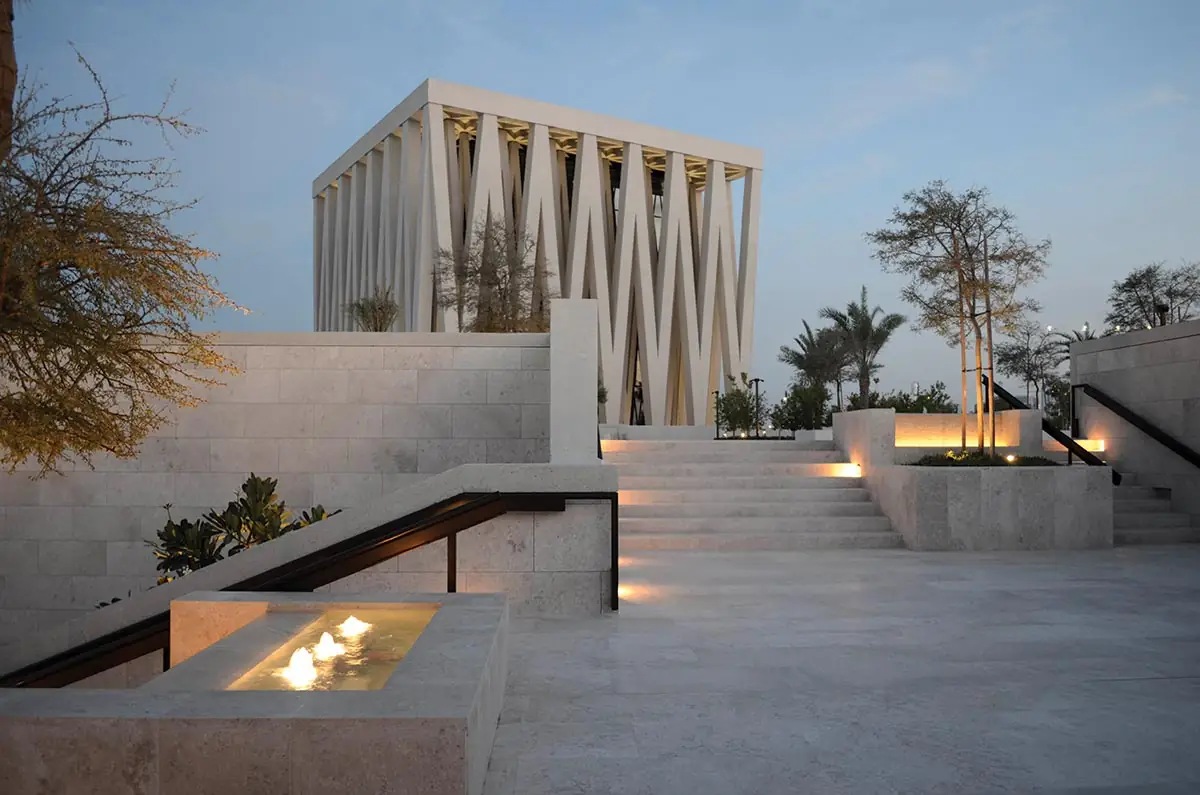
1
The synagogue (1 & 2) is defined by outer Y-shaped columns and an internal shroud-like scrim that mitigates glare. Photos © Stuart Rennie (1), Dror Baldinger (2)
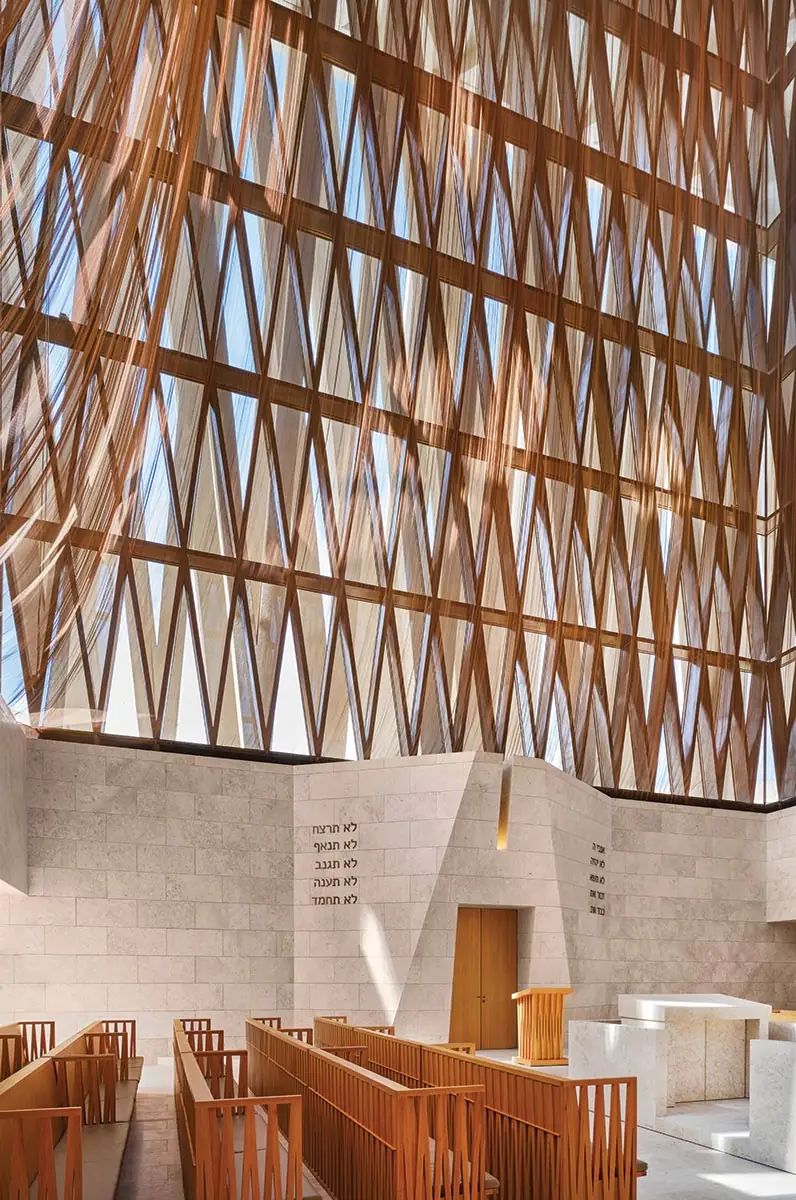
2
Occupying the remainder of the site is a one-story structure housing parking and a “welcome center,” which includes a café and central hall as well as a large, video-heavy exhibition trumpeting Emirati religious tolerance. Outdoor courtyards separate these spaces from the mosque, church, and synagogue, and from the smaller faith-specific spaces that ring each, engendering a definitive sense of arrival for visitors as they pass outdoors and are confronted with the heavy mass of each religious structure. Atop the one-story volume sits the central plaza, which, while effective as a visual datum, is far too hot under the brutal equatorial sun to allow for lingering during daylight hours.
Actually, it isn’t just the plaza. One does not feel welcome to linger anywhere in the Abrahamic House, except, perhaps, the welcome center’s exhibitions. Indeed, much of the complex’s programming is aimed at visitors rather than the faithful: guided tours are offered eight hours a day, five days a week. And each of the religious spaces is administered under a conservative interpretation of its respective faith that hardly feels welcoming to all. It’s no accident that Vatican officials were consulted on the design of the church or that Orthodox rabbis were consulted on that of the synagogue; and the mosque, like all Sunni mosques in the UAE, is governed by the national authority Awqaf, which prescribes a neotraditionalist version of Islam emphasizing adherence to scripture and discouraging political action. The Emirati leadership seems to have concluded that such rigid ideologies are the ones most easily co-opted by the state—and that they are unlikely to become threats to autocracy.
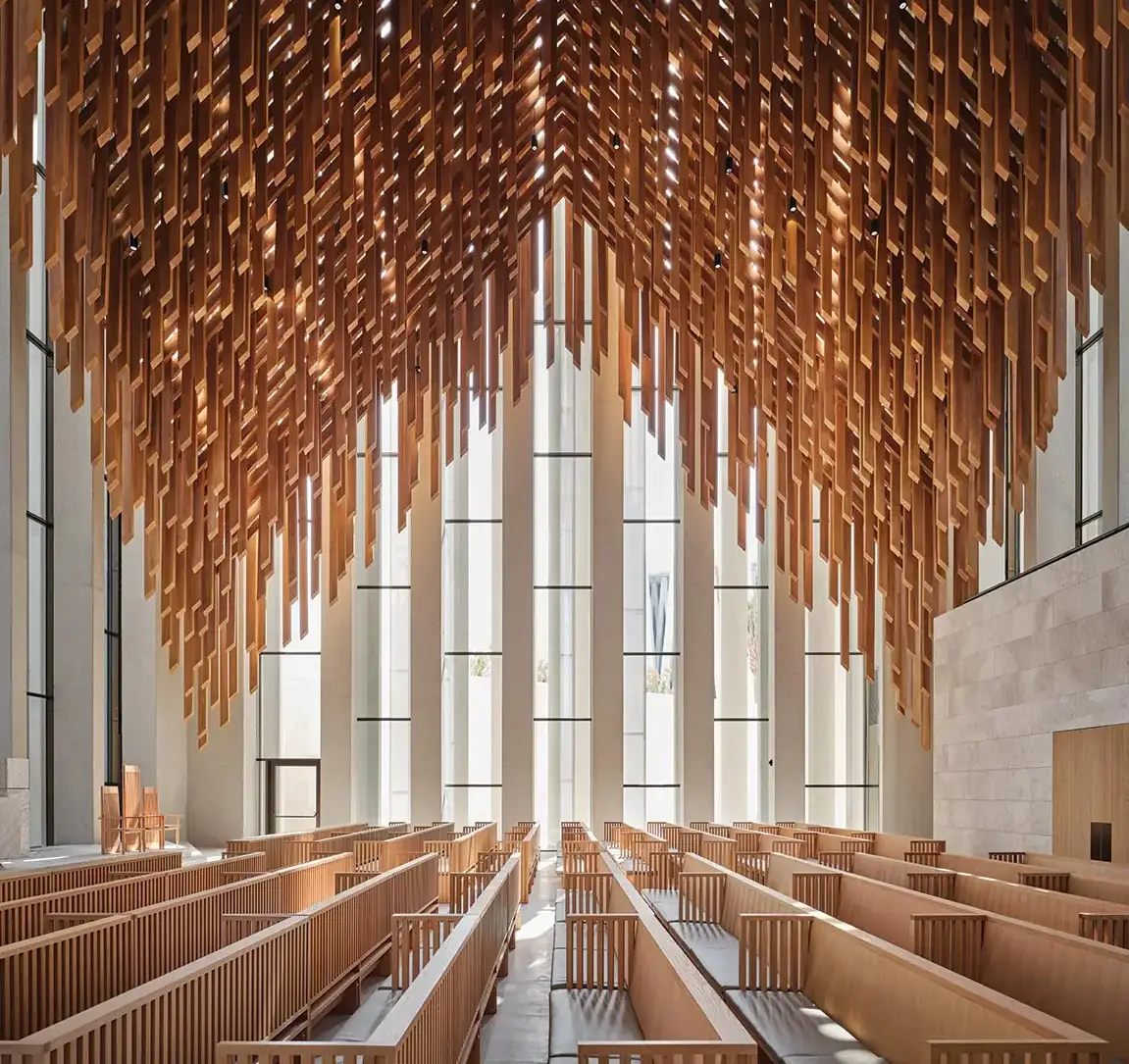
The church contains an installation of suspended oak posts that hovers above the worshippers. Photo © Dror Baldinger
An architectural review isn’t the place for a full assessment of the political agenda at work here. Nonetheless, the ethical issues that the project raises cannot be ignored—from its discomfiting vision of religion collapsed into state power to the military dealings it helps enable or its propagandistic value for a country that would prefer the world to overlook its treatment of the migrant laborers who built this and every other architectural wonder within its borders. On the other hand, the UAE’s efforts to position itself as a bastion of tolerance, self-serving though they are, have brought some welcome social changes. Last October, the UAE’s first purpose-built Hindu temple opened in Dubai—a landmark event, given that nearly a million UAE residents practice Hinduism—and another is under construction in Abu Dhabi. And this January, the Emirates became the first Gulf state to introduce the Holocaust into school curricula.
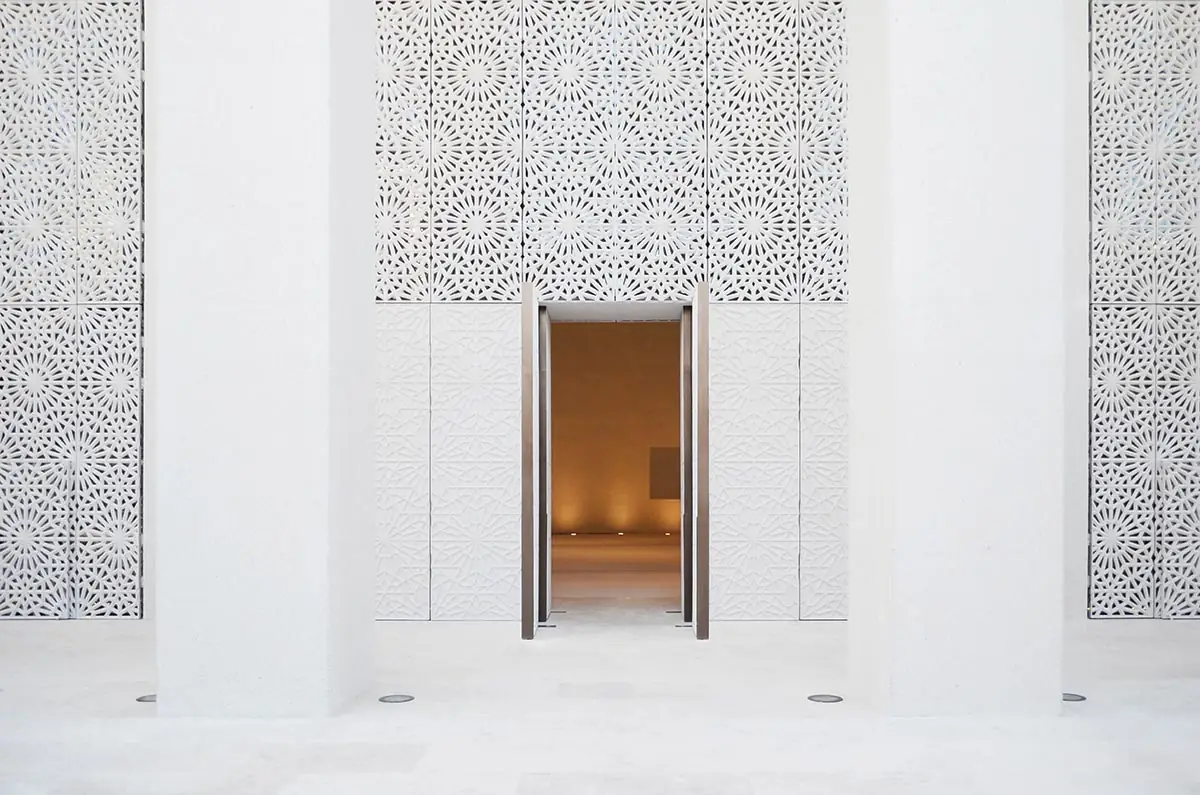
3
The mosque (3) glows at night through its arched screens (4). Photo © Stuart Rennie (3), Dror Baldinger (4)
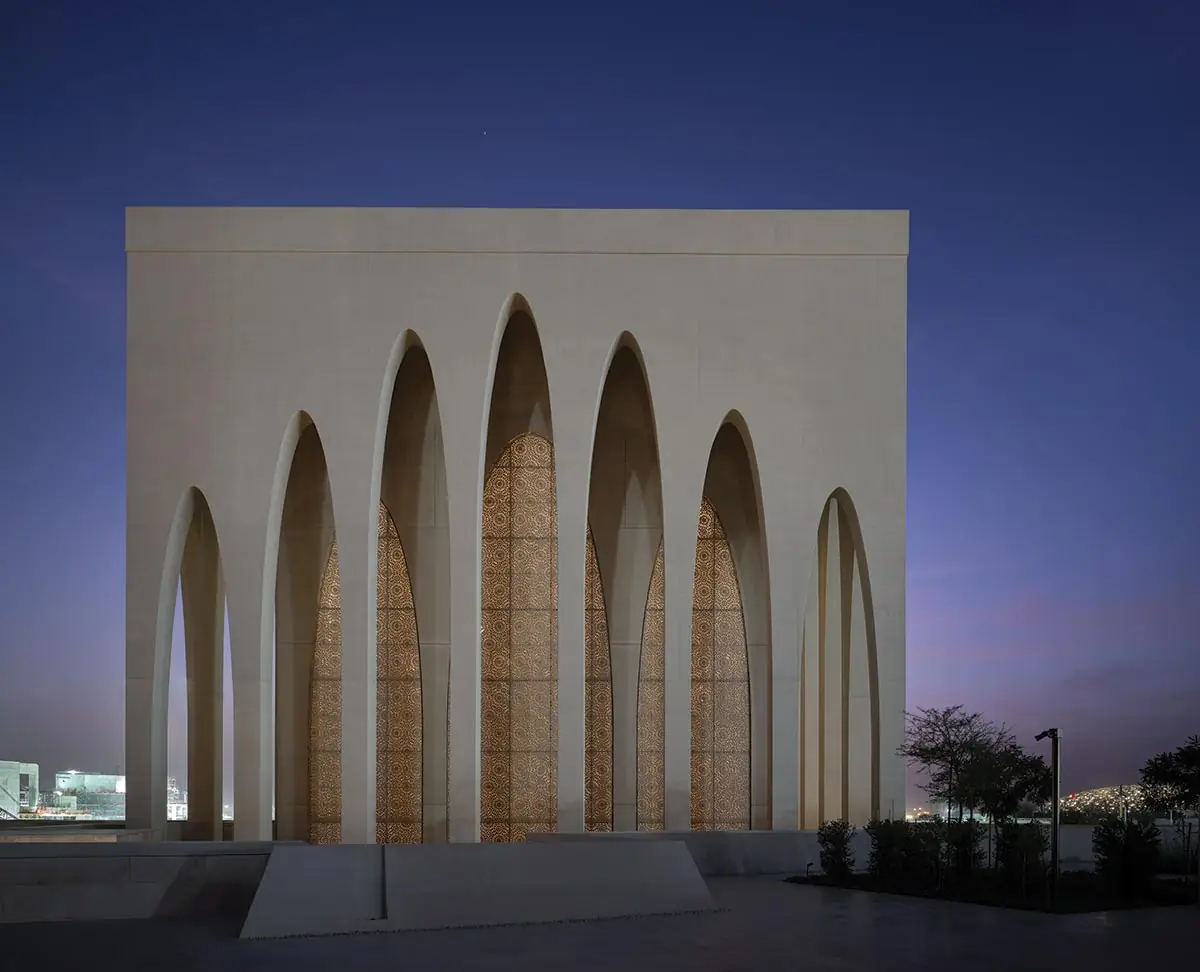
4
There are no easy answers here, and it would be simplistic to look down on those architects who take on work for the Emirati government—a group that includes not just Adjaye and Nouvel but also Frank Gehry and Norman Foster, among others. In the United States and Europe, after all, architecture is no less engaged in what the writer Deyan Sudjic calls the “dance with power” than it is in the Persian Gulf. The question is rather how architects undertaking such work might find, in the narrow gap between themselves and their clients, agency of their own—agency to create something of civic significance; agency to provoke audiences to think differently; agency, even, on occasion, to subvert clients’ ideological ends. Such agency is difficult to discern at the Abrahamic Family House, which today seems most effective as a work of architectural statecraft. But the question remains of how, in the coming years, the people of Abu Dhabi—the vast majority of them foreigners who have come from around the world in search of a better life—will make this complex their own. Is it too optimistic to hope that they come to feel a sense of belonging within these impressive halls of worship—and even find space to practice religion in ways that evade state control?
Click plans to enlarge
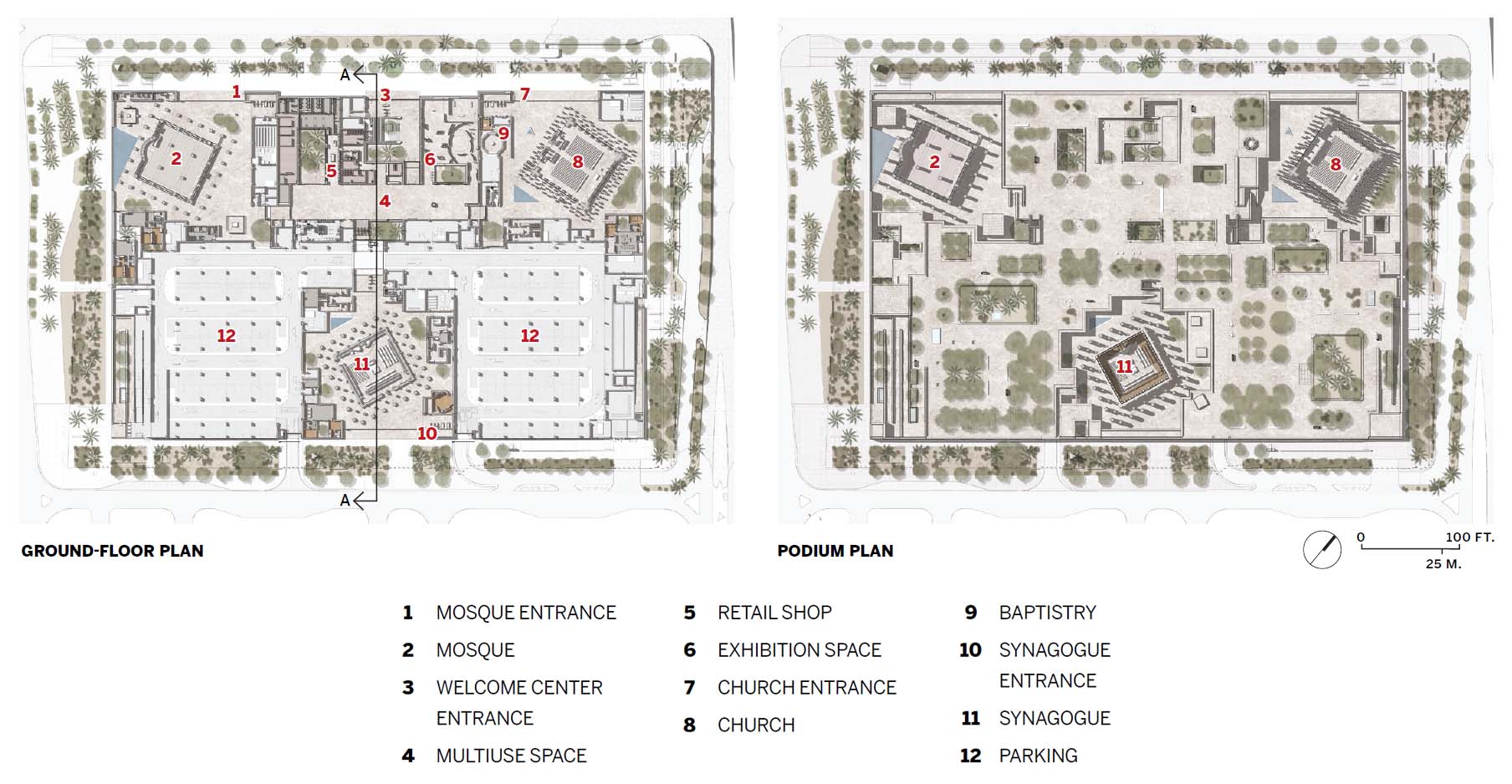
Click section to enlarge

Read RECORD’s interview with Adjaye.
Explore other spiritual buildings from the June 2023 issue.
Credits
Architect:
Adjaye Associates — Sir David Adjaye, principal; Yohannes Bereket, senior associate; Stuart Rennie, senior project architect; Trevore Grams, project architect; Kahila Hogarth, global head of interiors; Manuel Guemes, head of landscaping; Duncan Wilson, furniture and exhibition
Architect of Record:
AECOM
Engineers:
Buro Happold (competition to Stage 2); James L. Williams Middle East (m/e/p)
Consultants:
Maynard Design (signage/wayfinding); Arcadis (client project manager)
General Contractor:
Zublin Construction
Client:
United Arab Emirates Government
Size:
70,000 square feet
Cost:
Withheld
Completion Date:
January 2023
Sources
Omani Limestone:
Valencia Marble Factory
Metal Panels:
Super Sign
Curtain Wall:
Schüco, GEZE, Wall-Tech
Rainscreen:
Fibrex (mosque mashrabiya)
Glazing:
Dongguan CSG Architectural Glass
Concrete:
Abu Dhabi Precast
Fences & Gates:
Shahama Desert Metalwork
Interior Finishes:
Arabian Vermiculite Industries (acoustical plaster); Spazio Interiors (cabinetry, woodwork); Jotun Paints; FourStyle (wood paneling); RAK Ceramics (floor, wall tile); Harmony Furniture (timber battens)
Lighting:
Jiso Illuminación, Avolux, Roma Luce, Havit Lighting, Flexa, Novalux
Elevator:
Thyssen Krupp



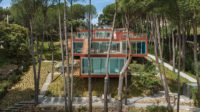
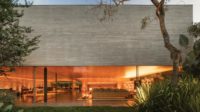
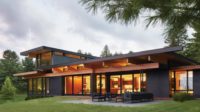
Post a comment to this article
Report Abusive Comment